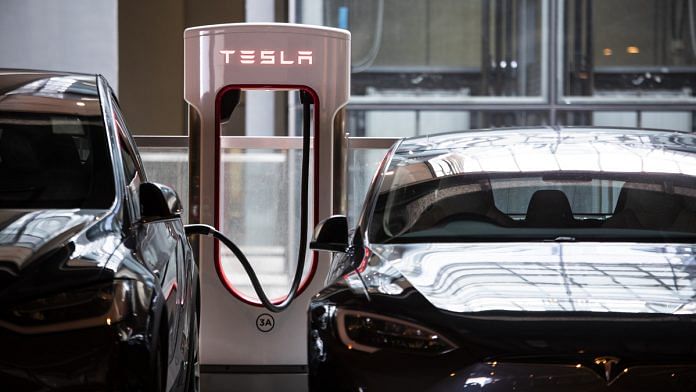China’s electric vehicle boom is moving ahead with full steam with Beijing developing a robust EV market. The emergence of China’s electric car industry could be a game changer for its economy.
You may have heard of Tesla, but do you know about Byton, BYD, SAIC, Nio, and XPeng? These are some of the most innovative EV companies in China that are going head-to-head with Tesla and other major EV companies elsewhere. For now, these companies completely dominate the Chinese market and are eating into Tesla’s business in China. In 2021, China’s EV industry was worth $124.21 billion.
Electric car sales in China are likely to reach 6 million by the end of 2022 as demand for the segment of vehicles has surged. China’s electric car industry is ahead of the US and Europe, where the projected sales for 2022 will stand around 1.2 million and 3.2 million, respectively.
China’s State Council has targeted making its entire public transportation fleet wholly electric by 2035. The province of Hainan is leading in promoting the EV boom. The province plans to completely phase out the sale of gasoline vehicles by 2030.
The Joe Biden administration in the US is concerned about China’s growing edge in the EV market. In February, the US Congress allocated $7.5 billion for EV charging infrastructure.
Also read: EVs ‘aren’t the answer’, Maruti Suzuki bets on hybrid technology, biofuels in clean shift
Coming together
But how are Chinese companies beating Tesla? By adapting to the new trends and developing solutions that can be quickly marketed to a large domestic audience.
Chinese companies are pooling together their best technological offering to develop a new line of EV cars for domestic and international markets.
A joint venture between state-owned Shanghai Automotive Industry Corporation (SAIC), US’ General Motors and Wuling Motors have launched an affordable electric car in Indonesia. Lu Kang, the Chinese ambassador in Jakarta, enthusiastically launched the new EV car for the Indonesian market in August.
That’s not the only EV joint venture fueling the EV frenzy. China’s leading battery company, CATL (Contemporary Amperex Technology Limited), has established a joint venture with state-owned Chang’an Automobile and tech company Huawei. The joint venture has just launched a new luxury EV brand, Avatr.
The three models of Avatr come fully equipped with Huawei technology, CATL’s batteries and the AVATRANS intelligent piloting system. The Avatr cars cost between $51,892 and $60,790.
China’s BYD is supplying EV buses to Bangalore Metropolitan Transport Corporation (BMTC) and the Telangana state through collaboration with Indian company Olectra Greentech Ltd. BYD has expanded its dealership network to eight cities across India despite the geopolitical tensions between India and China.
The use of Huawei’s technology in Chinese EV cars has raised concerns in the US but the Biden administration has approved the sale of semiconductor chip technology meat for the automotive industry.
The semiconductor chip technology is accelerating the IoT (Internet of Things) revolution in EV cars. Huawei is the leading provider within the segment as it has managed to secure semiconductor chips for car-related parts.
Also read: Volkswagen to test 1st electric car in India around September, aims to start selling next year
Does China innovate?
A long-held debate is how does China innovate, or does it even innovate? The answer is complicated.
Elizabeth Economy, senior advisor on China for the US Department of Commerce, and an acclaimed scholar on Chinese politics, described the Chinese approach to innovation in her book The Third Revolution: “China’s patents have generally been seen as incremental improvements on previous, more innovative work of others or are process driven— making something work faster, better, or more cheaply.”
Chinese companies, academic and research institutions are more focused on making incremental innovations and breakthroughs by developing technologies that are commercially viable.
Beijing set a target to achieve two million patents by 2015 and accomplished it before the deadline. But by 2014, over 60 per cent of the patents were under the “utility and design” category, which doesn’t represent a significant breakthrough or innovation. In 2016, 96 per cent of the patents in China were filed domestically.
The volume of Chinese academic institutions and private companies filing patents has increased exponentially, but that’s not indicative of a leap in innovation.
The gold standard of patent filing is the triadic patents filled in the leading global technology markets through the patent offices in the US, Japan, and Europe.
Though China has made improvements in the triadic patent filings between 2016 and 2021, it is still nowhere close to the US.
The incremental innovation model has been rewarded by the Chinese state through sustained funding of projects that don’t take off.
But the model has promoted a culture which is averse to taking risks and innovating in industries that may not provide financial rewards in the short run — the US and Europe remain ahead in fundamental research.
The EV boom in China is another example of Chinese companies incrementally innovating and selling at mass. The EV party in China isn’t ending anytime soon; the rest of the world will have to play catch up.
The author is a columnist and a freelance journalist. He was previously a China media journalist at the BBC World Service. He tweets @aadilbrar.
(Edited by Prashant)



